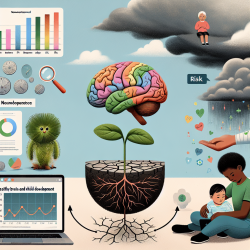Understanding Early Childhood Neurodevelopmental Assessment
The recent research article "Principles for Guiding the Selection of Early Childhood Neurodevelopmental Risk and Resilience Measures: HEALthy Brain and Child Development Study as an Exemplar" provides a comprehensive framework for assessing neurodevelopmental risks and resilience in early childhood. This blog aims to distill key insights from the study to help practitioners enhance their assessment strategies and improve outcomes for children.
The Importance of Data-Driven Decisions
In the field of speech-language pathology, data-driven decisions are crucial for tailoring interventions to the unique needs of each child. The HEALthy Brain and Child Development (HBCD) Study emphasizes the need for large-scale, nuanced assessments that consider both risk and resilience factors. This approach allows practitioners to identify early signs of neurodevelopmental challenges and implement timely interventions.
Key Principles for Effective Assessment
- Developmental Sensitivity: Assessments should be calibrated to the child's developmental stage, capturing the full spectrum of normative variation and maturational change.
- Lifespan Coherence: It's essential to characterize phenomena across developmental periods, ensuring continuity in assessment strategies.
- Pragmatic Strategies: Assessments should be feasible, scalable, and minimally burdensome, leveraging modern psychometric methods for efficiency.
- Strengths-Based Focus: Beyond risk detection, assessments should capture developmental strengths, wellbeing, and positive health indicators.
Application in Practice
Practitioners can apply these principles by integrating standardized tools like the NIH Toolbox and PhenX into their assessments. These tools offer validated measures that enable cross-study comparability and are designed to be developmentally sensitive. Additionally, practitioners should consider incorporating direct performance-based assessments to capture developmental heterogeneity and changes in a nuanced manner.
Encouraging Further Research
The HBCD Study serves as a model for future research, highlighting the importance of large, diverse cohorts and longitudinal designs. Practitioners are encouraged to stay informed about ongoing research and consider participating in studies that contribute to the growing body of knowledge on early childhood development.
To read the original research paper, please follow this link: Principles for Guiding the Selection of Early Childhood Neurodevelopmental Risk and Resilience Measures: HEALthy Brain and Child Development Study as an Exemplar.










